Media Concentration in Western Europe David Ward Centre


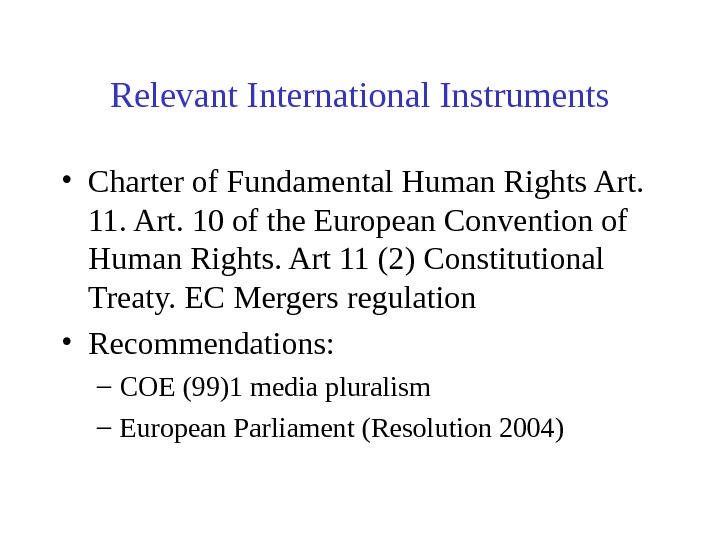
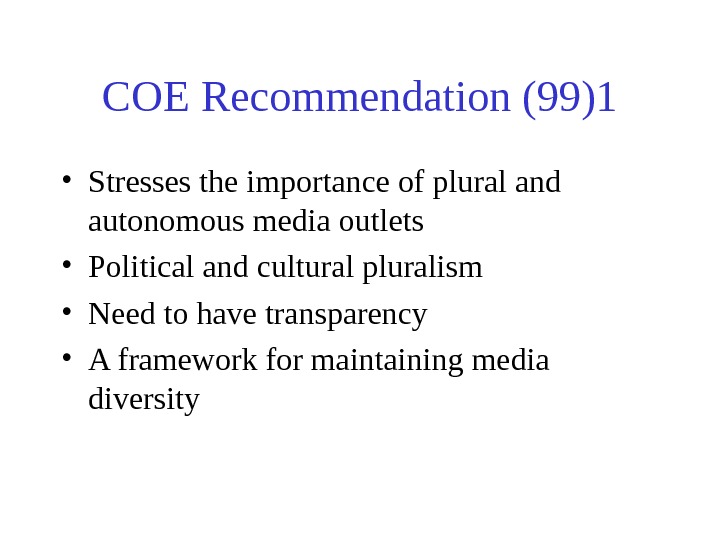
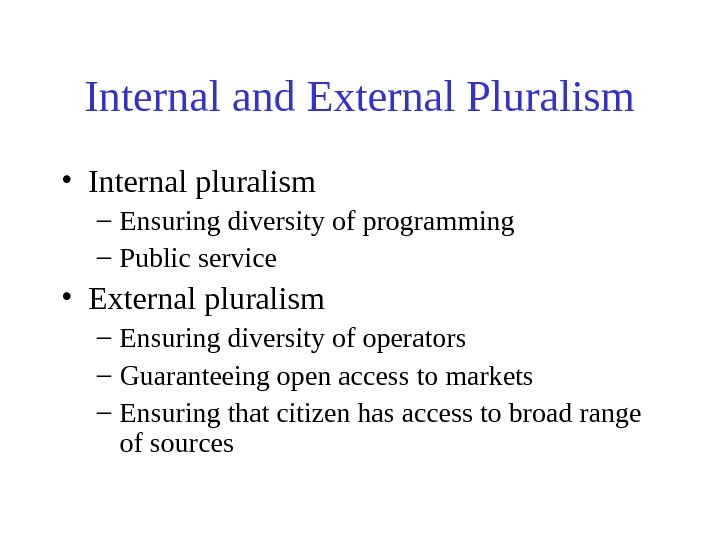




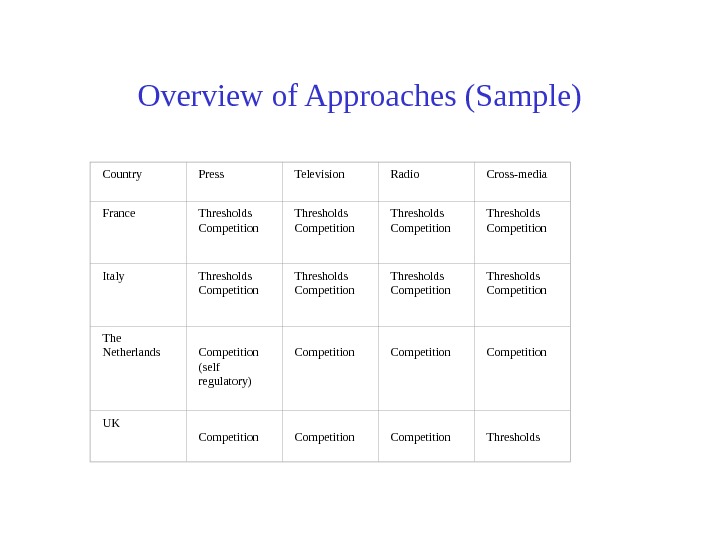

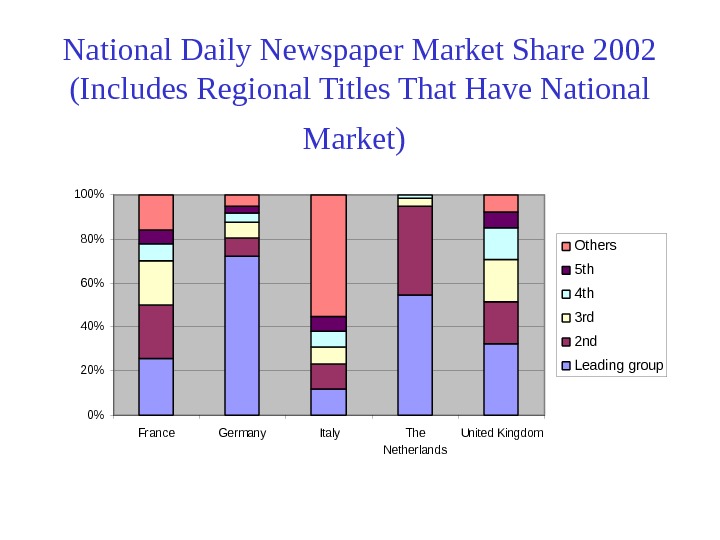
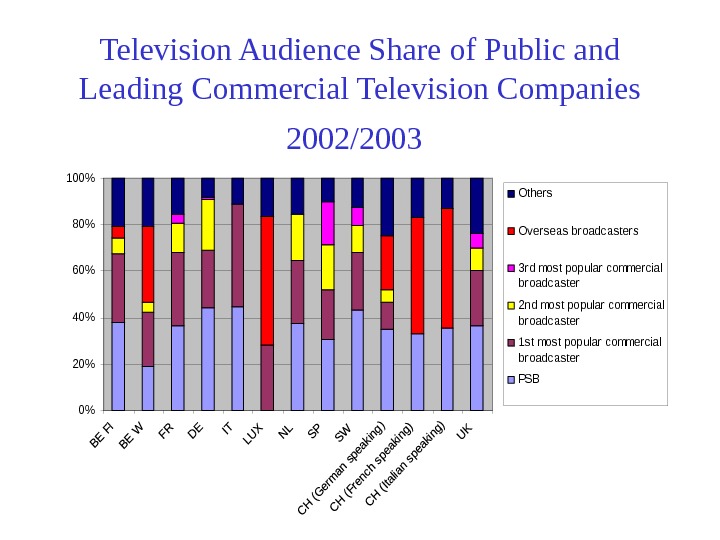

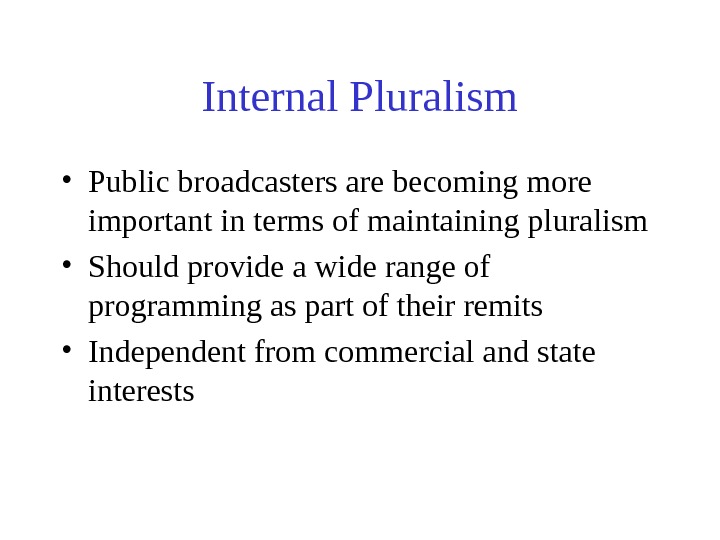


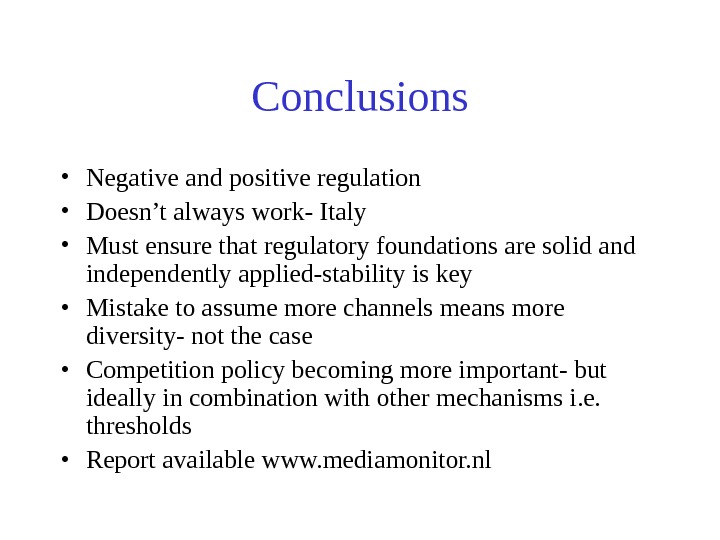
media_concentration_in_western_europe.ppt
- Размер: 96.5 Кб
- Количество слайдов: 18
Описание презентации Media Concentration in Western Europe David Ward Centre по слайдам
 Media Concentration in Western Europe David Ward Centre for Media Policy and Development
Media Concentration in Western Europe David Ward Centre for Media Policy and Development
 Why Regulate Media Concentration? • Normative • Basic right • Balance and pluralism • Public sphere • Market issues • Legal certainty • Fair and open competition • Monopolies • Open access
Why Regulate Media Concentration? • Normative • Basic right • Balance and pluralism • Public sphere • Market issues • Legal certainty • Fair and open competition • Monopolies • Open access
 Relevant International Instruments • Charter of Fundamental Human Rights Art. 11. Art. 10 of the European Convention of Human Rights. Art 11 (2) Constitutional Treaty. EC Mergers regulation • Recommendations: – COE (99)1 media pluralism – European Parliament (Resolution 2004)
Relevant International Instruments • Charter of Fundamental Human Rights Art. 11. Art. 10 of the European Convention of Human Rights. Art 11 (2) Constitutional Treaty. EC Mergers regulation • Recommendations: – COE (99)1 media pluralism – European Parliament (Resolution 2004)
 COE Recommendation (99)1 • Stresses the importance of plural and autonomous media outlets • Political and cultural pluralism • Need to have transparency • A framework for maintaining media diversity
COE Recommendation (99)1 • Stresses the importance of plural and autonomous media outlets • Political and cultural pluralism • Need to have transparency • A framework for maintaining media diversity
 Internal and External Pluralism • Internal pluralism – Ensuring diversity of programming – Public service • External pluralism – Ensuring diversity of operators – Guaranteeing open access to markets – Ensuring that citizen has access to broad range of sources
Internal and External Pluralism • Internal pluralism – Ensuring diversity of programming – Public service • External pluralism – Ensuring diversity of operators – Guaranteeing open access to markets – Ensuring that citizen has access to broad range of sources
 How Countries Regulate for External Pluralism • Range of different national approaches • Different media treated differently • Two main instruments – Competition policy (key today) – Thresholds (ceilings) • Both are reliant on a number of issues – Consistency – Clarity – Independence
How Countries Regulate for External Pluralism • Range of different national approaches • Different media treated differently • Two main instruments – Competition policy (key today) – Thresholds (ceilings) • Both are reliant on a number of issues – Consistency – Clarity – Independence
 Model 1 • Italy • Financial (30%) • National licences (20%) • These above provisions being removed by the new Bill • France • Shareholders (capped at 49% of channel with above 2. 5% share) • National licences (1 max) • Thresholds for cross-media
Model 1 • Italy • Financial (30%) • National licences (20%) • These above provisions being removed by the new Bill • France • Shareholders (capped at 49% of channel with above 2. 5% share) • National licences (1 max) • Thresholds for cross-media
 Model 2 • The Netherlands • No thresholds • Competition policy • Regulators would like to introduce thresholds • UK • Thresholds for cross-media (20% of newspaper market and ITV) • Competition policy • Public interest test for media has replaced all thresholds
Model 2 • The Netherlands • No thresholds • Competition policy • Regulators would like to introduce thresholds • UK • Thresholds for cross-media (20% of newspaper market and ITV) • Competition policy • Public interest test for media has replaced all thresholds
 Public Interest Test • Triggered where the public interest might be threatened- includes all mass media at the discretion of the DTI and Ofcom • Based on – Sufficient number of operators – Services to end user – Range of standards set out in the 2003 Act
Public Interest Test • Triggered where the public interest might be threatened- includes all mass media at the discretion of the DTI and Ofcom • Based on – Sufficient number of operators – Services to end user – Range of standards set out in the 2003 Act
 Overview of Approaches (Sample) Country Press Television Radio Cross-media France Thresholds Competition Italy Thresholds Competition The Netherlands Competition (self regulatory) Competition UK Competition Thresholds
Overview of Approaches (Sample) Country Press Television Radio Cross-media France Thresholds Competition Italy Thresholds Competition The Netherlands Competition (self regulatory) Competition UK Competition Thresholds
 Regional Newspaper Market Share of Top Five Groups 2002 (Includes Language Markets) 0%10%20%30%40%50%60%70%80%90%100%Others 5 th 4 th 3 rd 2 nd Leading group
Regional Newspaper Market Share of Top Five Groups 2002 (Includes Language Markets) 0%10%20%30%40%50%60%70%80%90%100%Others 5 th 4 th 3 rd 2 nd Leading group
 National Daily Newspaper Market Share 2002 (Includes Regional Titles That Have National Market) 0% 20% 40% 60% 80% 100% France. Germany. Italy. The Netherlands United Kingdom Others 5 th 4 th 3 rd 2 nd Leading group
National Daily Newspaper Market Share 2002 (Includes Regional Titles That Have National Market) 0% 20% 40% 60% 80% 100% France. Germany. Italy. The Netherlands United Kingdom Others 5 th 4 th 3 rd 2 nd Leading group
 Television Audience Share of Public and Leading Commercial Television Companies 2002/2003 0% 20% 40% 60% 80% 100% Others Overseas broadcasters 3 rd most popular commercial broadcaster 2 nd most popular commercial broadcaster 1 st most popular commercial broadcaster PS
Television Audience Share of Public and Leading Commercial Television Companies 2002/2003 0% 20% 40% 60% 80% 100% Others Overseas broadcasters 3 rd most popular commercial broadcaster 2 nd most popular commercial broadcaster 1 st most popular commercial broadcaster PS
 What Does This All Mean? • These are all highly concentrated markets • Very prominent position for the public sector (leaders in nearly all markets) • Growing consolidation of companies in press and TV • External pluralism narrowing- therefore internal pluralism becoming even more important
What Does This All Mean? • These are all highly concentrated markets • Very prominent position for the public sector (leaders in nearly all markets) • Growing consolidation of companies in press and TV • External pluralism narrowing- therefore internal pluralism becoming even more important
 Internal Pluralism • Public broadcasters are becoming more important in terms of maintaining pluralism • Should provide a wide range of programming as part of their remits • Independent from commercial and state interests
Internal Pluralism • Public broadcasters are becoming more important in terms of maintaining pluralism • Should provide a wide range of programming as part of their remits • Independent from commercial and state interests
 Common Features of Remits • Contribute to a democratic and plural society • Promote local culture • Provide high quality programming • Meet high journalistic standards • Non profit • Universal service
Common Features of Remits • Contribute to a democratic and plural society • Promote local culture • Provide high quality programming • Meet high journalistic standards • Non profit • Universal service
 Key issues • Need to provide pluralism for democratic and competition reasons- this is a non negotiable • Pluralism best served by the member states with support of international instruments • Crucial to maintain a balance between the rights of citizens and stability of the sector
Key issues • Need to provide pluralism for democratic and competition reasons- this is a non negotiable • Pluralism best served by the member states with support of international instruments • Crucial to maintain a balance between the rights of citizens and stability of the sector
 Conclusions • Negative and positive regulation • Doesn’t always work- Italy • Must ensure that regulatory foundations are solid and independently applied-stability is key • Mistake to assume more channels means more diversity- not the case • Competition policy becoming more important- but ideally in combination with other mechanisms i. e. thresholds • Report available www. mediamonitor. nl
Conclusions • Negative and positive regulation • Doesn’t always work- Italy • Must ensure that regulatory foundations are solid and independently applied-stability is key • Mistake to assume more channels means more diversity- not the case • Competition policy becoming more important- but ideally in combination with other mechanisms i. e. thresholds • Report available www. mediamonitor. nl
